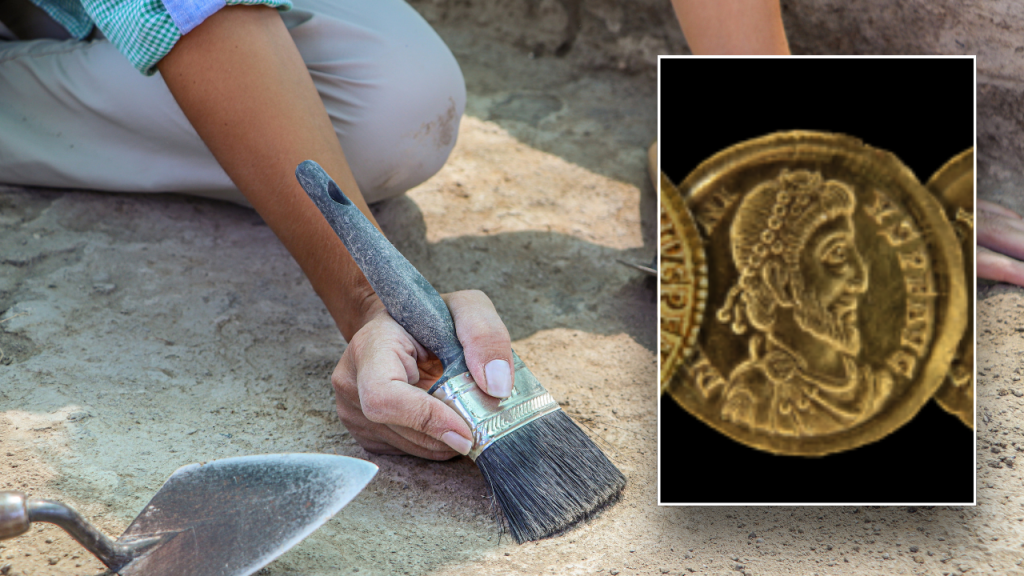A Glimpse into the Roman Empire: Unearthing a Trove of Gold Coins
The recent discovery of a remarkable cache of Roman gold coins in Luxembourg has captivated archaeologists and historians alike, offering a unique window into the tumultuous world of the late 4th century AD. The hoard, consisting of 141 solidi, or pure gold coins, represents an exceptionally rare find due to its completeness and the pristine condition of many of the coins. This discovery, the culmination of a meticulous four-year excavation project, is poised to shed light on the economic and political landscape of the late Roman Empire. The coins, featuring the likenesses of nine Roman emperors who reigned between 364 and 408 AD, bear silent witness to a period marked by both imperial grandeur and internal strife. One of the most intriguing aspects of the find is the presence of coins bearing the image of Eugenius, a usurper emperor whose brief reign challenged the authority of the Eastern Roman, or Byzantine, Empire.
Navigating the Perils of History: An Excavation Fraught with Challenges
The unearthing of this historical treasure was no simple task. The excavation site, scarred by the remnants of World War II, presented significant challenges to the archaeological team. The presence of unexploded ordnance, a legacy of the war, necessitated a cautious and painstaking approach. The Luxembourg Army’s Mine Clearance Service (SEDAL) played a crucial role, working in close collaboration with archaeologists to ensure the safety of all involved. This delicate operation, extending over several years, underlines the commitment to preserving both historical artifacts and human life. The fact that such a valuable hoard was recovered intact amidst these challenging circumstances makes the discovery even more remarkable.
A Usurper’s Legacy: The Enigma of Eugenius
Among the portraits of Roman emperors stamped onto the solidi, the image of Eugenius stands out. This usurper emperor, who held sway over the Western Roman Empire from 392 to 394 AD, was never recognized as a legitimate ruler by the Byzantine Empire. His reign, though brief, was a period of political instability and conflict. The presence of his coins within the hoard raises several intriguing questions. Was the individual who buried the coins a supporter of Eugenius? Did the coins represent a form of wealth accumulation during a time of turmoil? The answers to these questions may provide valuable insights into the political climate of the late Roman Empire. Eugenius’s ultimate defeat and execution at the Battle of the Frigidus in 394 AD marked the end of his reign and solidified the Byzantine Empire’s dominance.
A Puzzle Buried in Time: Unraveling the Mystery of the Hoard
The discovery of this hoard has sparked a flurry of speculation among archaeologists and historians. Why would such a significant amount of wealth be buried and seemingly abandoned? Was the owner forced to flee, intending to retrieve the coins later? Or was the burial a ritualistic act, perhaps connected to ancient beliefs or practices? The meticulous examination of the coins and their archaeological context is crucial to unraveling this mystery. The distribution of the coins, their condition, and the surrounding soil can offer clues to the circumstances surrounding the hoard’s burial. This forensic investigation into the past promises to reveal fascinating details about the life and times of those who lived during the late Roman Empire.
A Compensated Treasure: Recognizing the Value of the Past
Recognizing the historical significance of the find, the Luxembourg government awarded €308,600 (approximately $318,000) to the individuals who had legal claim to the hoard. This compensation reflects the importance placed on preserving historical artifacts and acknowledges the value of such discoveries to our understanding of the past. The valuation of the coins took into account their exceptional condition and the presence of rare specimens, particularly those featuring the image of Eugenius. This financial recognition highlights the collaborative effort between government authorities, archaeologists, and individuals in safeguarding cultural heritage.
A Ripple Effect of Discovery: Unearthing the Past Across Europe
The discovery of the Roman gold coins in Luxembourg is just one of several recent archaeological finds that have shed light on Europe’s rich history. From a 1,000-year-old coin hoard unearthed in Suffolk, England, to Viking graves brimming with treasures in Norway, these discoveries offer tantalizing glimpses into the lives of our ancestors. These findings underscore the importance of archaeological research and its ability to connect us to our shared past. Each discovery adds another piece to the intricate puzzle of history, revealing the stories of those who came before us and enriching our understanding of the human experience.

